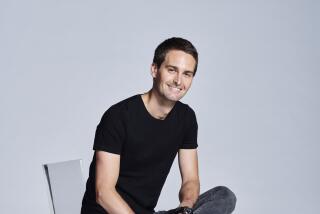Insta-rich: How Instagram became a $1-billion company in 18 months
How does a 28-year-old make $400 million in 18 months?
Kevin Systrom won the start-up sweepstakes with the right product at the right time: Instagram.
This young entrepreneur’s ambition to build the next big social network caught the attention of Facebook founder and Chief Executive Mark Zuckerberg, who paid a cool $1 billion to buy Instagram this week. That’s 1% of the valuation that Facebook is expected to fetch next month when it begins selling shares to the public for a tiny start-up that has never made a dime but soared to a loyal following of more than 30 million users just on Apple’s iPhone.
It was actually the third time Zuckerberg had tried to get Systrom on his team. The first time they crossed paths in 2004, Systrom was a Stanford undergrad building a photo-sharing service. Facebook was building its own photo-sharing feature and asked Systrom to work on it. Systrom wrestled with the decision but turned down the job offer. Years later when Instagram caught fire, Facebook tried to buy the company. Again, Systrom said no.
In an interview with the Los Angeles Times last year, Systrom said he was determined to create a “social tool for social life on the go.” He never once doubted he was building a $1 billion company. As such, it posed a competitive threat to Facebook, whose future depends on getting people to share more — and look at more ads — on their smartphones.
Systrom could not be reached for comment Tuesday. But last year, he telegraphed his intentions.
“We want to change the way people communicate and share in the real world,” Systrom said. “We’ll be focused on creating the features and products that people need to be able to do this.”
Facebook couldn’t pass up the opportunity to buy Instagram, even in the midst of its federally required quiet period in the run-up to its initial public stock offering.
On Friday, Instagram closed a $50 million funding round led by Sequoia Capital, which valued the company at $500 million. On Monday Facebook bought the San Francisco company with just 13 employees for $1 billion, doubling its value over the weekend.
And Systrom became insta-rich.
Instagram was the classic Silicon Valley success story in an age when young companies can amass a global following in weeks.
It took just eight weeks to build. It had 25,000 users in 24 hours, 200,000 in the first week, 1 million in less than three months.
“It was a huge surprise to us how many people intently started using the thing. We saw pictures from kids to pets to friends out drinking beer. The wide variety of stuff that we saw instantly made us feel like we weren’t just another Silicon Valley start-up,” Systrom said.
The San Francisco Giants were playing a few miles away. So he and co-founder Mike Krieger checked their database. They found 200 photos from the game.
Systrom credited Instagram’s early success to the community of users that has sprung up who comment and like each other’s photos.
“I remember thinking to myself, Instagram is going to be something,” Systrom said. “We hadn’t seen a product resonate and get people so excited so quickly. I knew at that moment, we had to put everything behind it.”
In February 2011, users had soared to 1.75 million and they were uploading 290,000 photos a day. Instagram raised $7 million to add to its initial seed round of $500,000. Benchmark Capital’s Matt Cohler, a former Facebook executive, led the funding round that valued the company at north of $20 million and also included prominent techies Twitter’s Jack Dorsey and Quora’s Adam D’Angelo.
“We chose Matt because he had a ton of operational experience building social companies,” Systrom said. Cohler, who still works closely with Facebook and Zuckerberg, sits on Instagram’s board.
Instagram was already on Facebook’s radar screen. Instagram turned down a buyout offer, and redoubled their efforts. Systrom banned meetings with anyone outside the company except for the media and engineering recruits to stay focused.
The strategy paid off. Celebrities such as Justin Bieber flocked to the site. Companies seeking to promote their products, such as Kate Spade, Nike, Red Bull and Starbucks, also joined the fray.
In August, Instagram hit a major milestone: 150 million photos had been uploaded in the nine months since it had launched. Systrom was giddy.
“Today, we see 1.3 million photos uploaded every single day – that’s 15 photos per second. To say that we’re excited and humbled by the initial success of Instagram would be an understatement,” Systrom said at the time. “I believe it marks the beginning of what’s to come. We’re one of the fastest growing social networks in mobile.”
Last week Instagram unleashed an even bigger weapon: its new app for mobile phones running Google’s Android operating system. It has already hit 5 million downloads.
RELATED:
Facebook to snap up Instagram photo-sharing app for $1 billion
Instagram for Android hits 5 million downloads already
Tech entrepreneur Kevin Systrom is focused on photography
Insta-rich: How Instagram became a $1-billion company in 18 months
More to Read
Inside the business of entertainment
The Wide Shot brings you news, analysis and insights on everything from streaming wars to production — and what it all means for the future.
You may occasionally receive promotional content from the Los Angeles Times.










